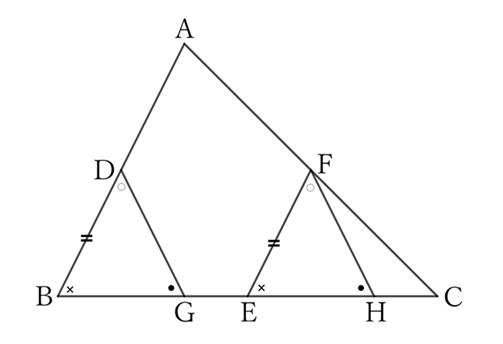Problem
Let $D, \ E$ and $F$ be the midpoints of the sides $AB, \ BC$ and $CA$ of $△ABC$, respectively.
Draw parallel lines in any direction from $D$ and $F$, and let $G$ and $H$ be the points where they intersect with $BC$, respectively. Then,
$$BG=EH.$$
$$ $$
$$ $$
$\downarrow$ $\downarrow$ $\downarrow$ $\downarrow$ $\downarrow$
$$ $$
$$ $$
$$ $$
$$ $$
$$ $$
$$ $$
$$ $$
$$ $$
$$ $$
$$ $$
Solution

Since $DG∥FH$,
$$∠DGB=∠FHE. \qquad [1]$$
Since $△ABC$ and $△FEC$ share $∠C$, $AC∶FC=2∶1$ and $BC∶EC=2∶1$,
$$△ABC \sim △FEC,$$
$$∴ \ AB∶FE=2∶1,$$
$$∴ \ DB=FE. \qquad [2]$$
Since $AB∥FE$,
$$∠DBG=∠FEH. \qquad [3]$$
From $[1]$ and $[3]$,
$$∠BDG=∠EFH. \qquad [4]$$
From $[2], \ [3]$ and $[4]$,
$$△DBG≡△FEH,$$
$$∴ \ BG=EH.$$
$ $
$ $
$ $
Reference Teiichiro Sasabe (1976) The Encyclopedia of Geometry (2nd edition), Seikyo-Shinsha, p.27.